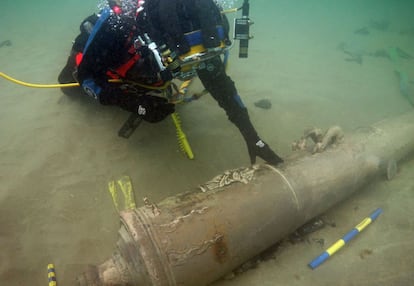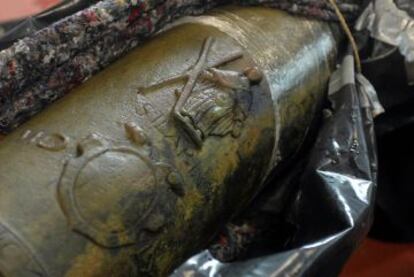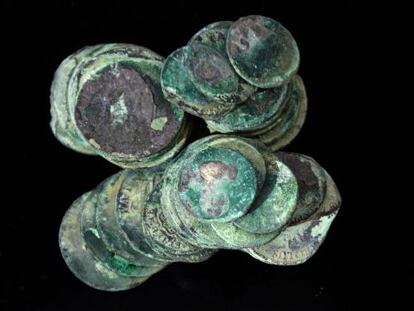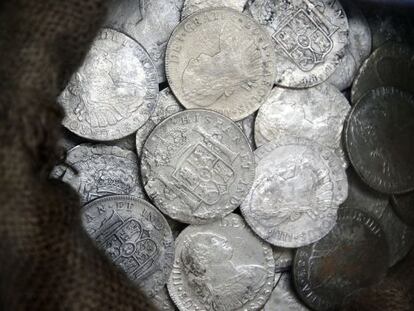Ireland and Spain to cooperate on protecting Spanish Armada wrecks
Discovery of nine cannons from ‘La Juliana,’ which sank in 1588, prompts deal

Deep in the bowels of the National Museum of Ireland in Dublin lies a treasure trove that could represent a new approach to preserving Spain’s underwater heritage: nine bronze cannons, part of the total of 32 that were aboard La Juliana, a former merchant vessel-turned-Spanish Armada warship that sank off the west coast of Ireland on September 21, 1588 as it tried to make its way back home.
Recovered last summer from the seabed near Streedagh, north of the city of Sligo, along with other artifacts, the cannons will not go on display for another two years.
The agreement between the Irish and Spanish culture ministries will mean permanent cooperation in all matters related to the Spanish Armada ARQUA’s Iván Negueruela
“During that time they will be my guests, and I’ll be giving them my undivided attention,” says Rolly Read, the head of the museum’s preservation department, as he winds his way through the narrow corridors that lie beneath the institution to the room where the cannons are kept.
A couple of weeks ago a group of senior officials from Spain's Ministry of Culture and the National Museum of Underwater Archeology (ARQUA) in Cartagena were here to forge closer cooperation so that some of the cannons still lying on the seabed off Streedagh can also eventually be recovered.

“The agreement between the Irish and Spanish culture ministries will mean permanent cooperation in all matters relating to the Spanish Armada,” says ARQUA’s Iván Negueruela, barely containing his excitement at this major development in protecting Spanish shipwrecks and their contents lying in Irish waters. “We will be providing our Irish counterparts with any documentation we have that they need to help map or trace vessels, and they will be able to count on us to work closely with them on future underwater projects,” he adds.
The nine cannons recovered so far are being carefully and slowly cleaned in special water tanks. During the process, the team from Ireland’s Underwater Archeology Unit (UAU) has discovered that the guns were made in 1570 in Genoa by Doria Il Gioardi. Each has been inscribed with the name of a saint: San Severo, San Giovanni, Santa Madrona...
“We need to remember that in taking on the protestant vessels of the English or those of the Islamic Turks, these vessels were waging an ideological war, a religious war that was powerfully symbolized by these saints,” explains Fionnbarr Moore, who led the diving expedition that recovered the cannons. La Juliana also fought in the Battle of Lepanto, in 1571, when a combined Christian force defeated the Ottoman Turks.
In taking on the protestant vessels of the English or those of the Islamic Turks, these vessels were waging an ideological war
Fionnbarr Moore, expedition director
The team at the National Museum of Ireland says the cleaning process will yield further information about the guns, and perhaps even a few surprises. “The Spanish Armada always keeps an ace up its sleeve,” says Read, telling the story of a British specialist brought in to restore one of the smaller guns discovered back in the 1980s.
“As he removed the cannon from the hot water tank it had been kept in for cleaning, a projectile that had been lodged in the barrel suddenly came loose and fell into the water, making a huge splash and drenching him. That was its final shot, La Juliana’s last surprise.”
Tu suscripción se está usando en otro dispositivo
¿Quieres añadir otro usuario a tu suscripción?
Si continúas leyendo en este dispositivo, no se podrá leer en el otro.
FlechaTu suscripción se está usando en otro dispositivo y solo puedes acceder a EL PAÍS desde un dispositivo a la vez.
Si quieres compartir tu cuenta, cambia tu suscripción a la modalidad Premium, así podrás añadir otro usuario. Cada uno accederá con su propia cuenta de email, lo que os permitirá personalizar vuestra experiencia en EL PAÍS.
¿Tienes una suscripción de empresa? Accede aquí para contratar más cuentas.
En el caso de no saber quién está usando tu cuenta, te recomendamos cambiar tu contraseña aquí.
Si decides continuar compartiendo tu cuenta, este mensaje se mostrará en tu dispositivo y en el de la otra persona que está usando tu cuenta de forma indefinida, afectando a tu experiencia de lectura. Puedes consultar aquí los términos y condiciones de la suscripción digital.










































